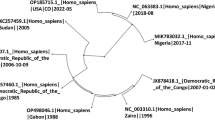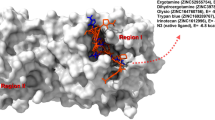Abstract
Chikungunya virus (CHIKV) infection and subsequent high patient morbidity is a global threat. The present study aimed to identify the potent antiviral agent against Chikungunya virus, with minimum in vitro cytotoxicity. CHIKV nsP4 3D structure was determined using the I-TASSER server followed by its refinement and pocket determination. Furthermore, high-throughput molecular docking was employed to identify candidate CHIKV nsP4 inhibitors in a library containing 214 compounds. The top ranked compound was evaluated further with various assays, including cytotoxicity, antiviral activity, time of drug addition, viral entry attachment, and microneutralization assays. High-throughput computational screening indicated silibinin to have the best interaction with CHIKV nsP4 protein, immature and mature glycoproteins with highest negative free binding energy, − 5.24 to − 5.86 kcal/mol, and the lowest inhibitory constant, 50.47 to 143.2 µM. Further in vitro analysis demonstrated silibinin could exhibit statistically significant (p < 0.05) dose-dependent anti-CHIKV activity within 12.5–100-µM concentrations with CC50 as 50.90 µM. In total, 50 µM silibinin interfered with both CHIKV attachment (75%) and entry (82%) to Vero cells. Time of addition assay revealed silibinin interfered with late phase of the CHIKV replication cycle. Microneutralization assay revealed that silibinin could inhibit clearing of 50% Vero cell monolayer caused by CHIKV-induced CPE at a minimum dose of 25 µM. These data indicated silibinin to be a promising candidate drug against CHIKV infection.






Similar content being viewed by others
References
Ahmed-Belkacem A, Ahnou N, Barbotte L, Wychowski C, Pallier C, Brillet R, Pohl RT, Pawlotsky JM (2010) Silibinin and related compounds are direct inhibitors of hepatitis C virus RNA-dependent RNA polymerase. Gastroenterology 138(3):1112–1122. https://doi.org/10.1053/j.gastro.2009.11.053
Ahmed-Belkacem A, Guichou JF, Brillet R, Ahnou N, Hernandez E, Pallier C, Pawlotsky JM (2014) Inhibition of RNA binding to hepatitis C virus RNA-dependent RNA polymerase: a new mechanism for antiviral intervention. Nucleic Acids Res. 42(14):9399–409. https://doi.org/10.1093/nar/gku632
Akahata W, Yang ZY, Andersen H, Sun S, Holdaway HA, Kong WP, Lewis MG, Higgs S, Rossmann MG, Rao S, Nabel GJ (2010) A virus-like particle vaccine for epidemic Chikungunya virus protects nonhuman primates against infection. Nat Med. 16(3):334–8. https://doi.org/10.1038/nm.2105
Alam I, Lee JH, Cho KJ, Han KR, Yang JM, Chung MS, Kim KH (2012) Crystal structures of murine norovirus-1 RNA-dependent RNA polymerase in complex with 2-thiouridine or ribavirin. Virology 426(2):143–151. https://doi.org/10.1016/j.virol.2012.01.016
Anusuya S, Gromiha MM (2017) Quercetin derivatives as non-nucleoside inhibitors for dengue polymerase: molecular docking, molecular dynamics simulation, and binding free energy calculation. J Biomol Struct Dyn 35(13):2895–2909. https://doi.org/10.1080/07391102.2016.1234416
Artimo P, Jonnalagedda M, Arnold K, Baratin D, Csardi G, de Castro E, Duvaud S, Flegel V, Fortier A, Gasteiger E, Grosdidier A, Hernandez C, Ioannidis V, Kuznetsov D, Liechti R, Moretti S, Mostaguir K, Redaschi N, Rossier G, Xenarios I, Stockinger H (2012) ExPASy: SIB bioinformatics resource portal. Nucleic Acids Res. 40(Web Server issue):W597–W603. https://doi.org/10.1093/nar/gks400
Buchan DW, Minneci F, Nugent TC, Bryson K, Jones DT (2013) Scalable web services for the PSIPRED Protein Analysis Workbench. Nucleic Acids Res. 41(Web Server issue):W349–W357. https://doi.org/10.1093/nar/gkt381
Cruz DJ, Bonotto RM, Gomes RG, da Silva CT, Taniguchi JB, No JH, Lombardot B, Schwartz O, Hansen MA, Freitas-Junior LH (2013) Identification of novel compounds inhibiting chikungunya virus-induced cell death by high throughput screening of a kinase inhibitor library. PLoSNegl Trop Dis 7(10):e2471. https://doi.org/10.1371/journal.pntd.0002471
Cunha RVD, Trinta KS (2017) Chikungunya virus: clinical aspects and treatment - a review. Mem Inst Oswaldo Cruz 112(8):523–531. https://doi.org/10.1590/0074-02760170044
Drwal MN, Banerjee P, Dunkel M, Wettig MR, Preissner R (2014) ProTox: a web server for the in silico prediction of rodent oral toxicity. Nucleic Acids Res. 42(Web Server issue):W53–W58. https://doi.org/10.1093/nar/gku401
Dutta SK, Bhattacharya T, Tripathi A (2018) Chikungunya virus: genomic microevolution in Eastern India and its in-silico epitope prediction. 3 Biotech 8(7):318. https://doi.org/10.1007/s13205-018-1339-3
Ferrè F, Clote P (2006) DiANNA 1.1: an extension of the DiANNA web server for ternary cysteine classification. Nucleic Acids Res 34(1):W182–W185. https://doi.org/10.1093/nar/gkl189
Ghildiyal R, Gupta S, Gabrani R et al (2019) In silico study of chikungunya polymerase, a potential target for inhibitors. Virusdisease 30(3):394–402. https://doi.org/10.1007/s13337-019-00547-0
Hsu KC, Chen YF, Lin SR, Yang JM (2011) iGEMDOCK: a graphical environment of enhancing GEMDOCK using pharmacological interactions and post-screening analysis. BMC Bioinformatics 12 Suppl 1(Suppl 1):S33. https://doi.org/10.1186/1471-2105-12-S1-S33
Kaur P, Thiruchelvan M, Lee RC, Chen H, Chen KC, Ng ML, Chu JJ (2013) Inhibition of chikungunya virus replication by harringtonine, a novel antiviral that suppresses viral protein expression. Antimicrob Agents Chemother. 57(1):155–67. https://doi.org/10.1128/AAC.01467-12
Kitaoka S, Konno T, De Clercq E (1986) Comparative efficacy of broad-spectrum antiviral agents as inhibitors of rotavirus replication in vitro. Antiviral Res 6(1):57–65. https://doi.org/10.1016/0166-3542(86)90039-2
Kumar P, Kapopara RG, Patni M, Pandya H, Jasrai Y, Patel S (2012) Exploring the polymerase activity of chikungunya viral non structural protein 4 (nsP4) using molecular modeling, e- pharmacophore and docking studies. Int J Pharm Life Sci 3:1752–1765
Laskowski RA, Swindells MB (2011) LigPlot+: multiple ligand-protein interaction diagrams for drug discovery. J Chem Inf Model 51(10):2778–2786. https://doi.org/10.1021/ci200227u
Lello LS, Bartholomeeusen K, Wang S et al (2021) nsP4 is a major determinant of alphavirus replicase activity and template selectivity. J Virol 95(20):e0035521. https://doi.org/10.1128/JVI.00355-21
McClure J, Lovelace ES, Elahi S, Maurice NJ, Wagoner J, Dragavon J, Mittler JE, Kraft Z, Stamatatos L, Horton H, De Rosa SC, Coombs RW, Polyak SJ (2012) Silibinin inhibits HIV-1 infection by reducing cellular activation and proliferation. PLoS One 7(7):e41832. https://doi.org/10.1371/journal.pone.0041832. Epub 2012 Jul 25. Erratum in: PLoS One. 2012;7(10). doi: https://doi.org/10.1371/annotation/78ba072a-6b7a-430a-8fcd-ef020e4fc458. Stamatatos, Leonidis [corrected to Stamatatos, Leonidas].
Moghaddam E, Teoh BT, Sam SS, Lani R, Hassandarvish P, Chik Z, Yueh A, Abubakar S, Zandi K (2014) Baicalin, a metabolite of baicalein with antiviral activity against dengue virus. Sci Rep 26(4):5452. https://doi.org/10.1038/srep05452.PMID:24965553;PMCID:PMC4071309
O’Boyle NM, Banck M, James CA, Morley C, Vandermeersch T, Hutchison GR (2011) Open Babel: an open chemical toolbox. J Cheminform 7(3):33. https://doi.org/10.1186/1758-2946-3-33
Oliveira AF, Teixeira RR, Oliveira AS, Souza AP, Silva ML, Paula SO (2017) Potential antivirals: natural products targeting replication enzymes of dengue and chikungunya viruses. Molecules 22(3):505. https://doi.org/10.3390/molecules22030505
Parashar D, Cherian S (2014) Antiviral perspectives for chikungunya virus. Biomed Res Int. 2014:631642. https://doi.org/10.1155/2014/631642
Ravichandran R, Manian M (2008) Ribavirin therapy for Chikungunya arthritis. J Infect Dev Ctries 2(2):140–142
Saganuwan SA (2020) Comparative therapeutic index, lethal time and safety margin of various toxicants and snake antivenoms using newly derived and old formulas. BMC Res Notes 13(1):292. https://doi.org/10.1186/s13104-020-05134-x
Sengupta S, Mukherjee S, Haldar SK, Bhattacharya N, Tripathi A (2020) Re-emergence of Chikungunya virus infection in Eastern India. Braz J Microbiol. 51(1):177–182. https://doi.org/10.1007/s42770-019-00212-0
Subudhi BB, Chattopadhyay S, Mishra P, Kumar A (2018) Current strategies for inhibition of chikungunya infection. Viruses 10(5):235. https://doi.org/10.3390/v10050235
Sui J, Li W, Murakami A, Tamin A, Matthews LJ, Wong SK, Moore MJ, Tallarico AS, Olurinde M, Choe H, Anderson LJ, Bellini WJ, Farzan M, Marasco WA (2004) Potent neutralization of severe acute respiratory syndrome (SARS) coronavirus by a human mAb to S1 protein that blocks receptor association. Proc Natl Acad Sci U S A 101(8):2536–2541. https://doi.org/10.1073/pnas.0307140101
Tong WW, Zhang C, Hong T, Liu DH, Wang C, Li J, He XK, Xu WD (2018) Silibinin alleviates inflammation and induces apoptosis in human rheumatoid arthritis fibroblast-like synoviocytes and has a therapeutic effect on arthritis in rats. Sci Rep 8(1):3241. https://doi.org/10.1038/s41598-018-21674-6
Trott O, Olson AJ (2010) AutoDock Vina: improving the speed and accuracy of docking with a new scoring function, efficient optimization, and multithreading. J Comput Chem 31(2):455–461. https://doi.org/10.1002/jcc.21334
Umetsu T, Inoue J, Kogure T, Kakazu E, Ninomiya M, Iwata T, Takai S, Nakamura T, Sano A, Shimosegawa T (2018) Inhibitory effect of silibinin on hepatitis B virus entry. BiochemBiophys Rep 31(14):20–25. https://doi.org/10.1016/j.bbrep.2018.03.003
Voss JE, Vaney MC, Duquerroy S, Vonrhein C, Girard-Blanc C, Crublet E, Thompson A, Bricogne G, Rey FA (2010) Glycoprotein organization of Chikungunya virus particles revealed by X-ray crystallography. Nature 468(7324):709–712. https://doi.org/10.1038/nature09555
Wada Y, Orba Y, Sasaki M et al (2017) Discovery of a novel antiviral agent targeting the nonstructural protein 4 (nsP4) of chikungunya virus. Virology 505:102–112. https://doi.org/10.1016/j.virol.2017.02.014
Wahid B, Ali A, Rafique S, Idrees M (2017) Global expansion of chikungunya virus: mapping the 64-year history. Int J Infect Dis. 58:69–76. https://doi.org/10.1016/j.ijid.2017.03.006
Yang J, Zhang Y (2015) I-TASSER server: new development for protein structure and function predictions. Nucleic Acids Res. 43(W1):W174–W181. https://doi.org/10.1093/nar/gkv342
Funding
This study was partly funded by Department of Biotechnology, Government of West Bengal, India [No.132-BT (Estt.) /RD-1/10].
Author information
Authors and Affiliations
Corresponding author
Ethics declarations
Competing interests
The authors declare no competing interests.
Supplementary Information
Below is the link to the electronic supplementary material.
11626_2022_666_MOESM1_ESM.doc
Supplementary file1 Different grid coordinates x, y, z; spacing; grid box size and location of immature and mature glycoprotein structure considered for autodock analysis. (DOC 29 KB)
11626_2022_666_MOESM2_ESM.doc
Supplementary file2 Binding energy of CHIKV nsP4 protein with selected 214 compounds considered for primary screening by iGEMDOCK v.2. (DOC 257 KB)
Rights and permissions
About this article
Cite this article
Dutta, S.K., Sengupta, S. & Tripathi, A. In silico and in vitro evaluation of silibinin: a promising anti-Chikungunya agent. In Vitro Cell.Dev.Biol.-Animal 58, 255–267 (2022). https://doi.org/10.1007/s11626-022-00666-x
Received:
Accepted:
Published:
Issue Date:
DOI: https://doi.org/10.1007/s11626-022-00666-x




